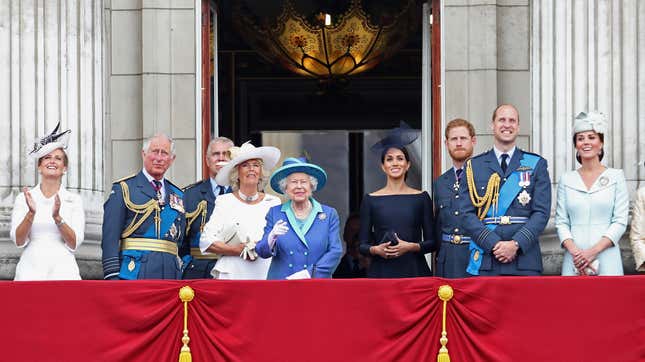This Is Court Intrigue in Real-Time
In Depth
Image: (Photo by Chris Jackson/Getty Images)
On March 7, CBS will premiere what’s likely to be a marquee television event of the year: Oprah Winfrey’s interview with the Sussexes, Harry and Meghan, about their lives, causes, and—most sensationally—the chain of events that saw them bail on their lives as working royals in favor of Santa Barbara. CBS has already begun rolling out dramatic promo clips, with Oprah clearly setting the stakes: “I just want to make it clear to everybody, there is no subject that is off-limits.” It goes without saying that the royal mothership is concerned about what the couple might say. And now, just days before the primetime special is scheduled to air, the Times of London has published a story alleging that Meghan was accused of “bullying” by Kensington Palace aides.
For generations, the Windsors have successfully positioned themselves as a “royal family,” emphasis on the cozy second half of that phrase. But right now the whole institution is reverting to centuries-old patterns, and the entire world is watching Tudor-level court intrigue unfold in real-time, on a global stage, at the speed of Twitter. There are multiple players here: Buckingham Palace, Clarence House, Kensington Palace, and the Sussexes’ new American-based operation, staffed with the modern descendants of the secret-trading courtiers who surrounded Henry VIII. The knives are out—with major reputational stakes for the parties involved, and the monarchy itself.
The relationship between Meghan and the largely conservative British press started off rocky and never quite recovered; Harry had his own ugly history with the tabloids, tied into the trauma of his mother’s death and marked with genuinely invasive maneuvers like the News of the World’s phone-hacking operation. By 2018, there was a steady drumbeat of stories that cast Meghan as difficult, demanding, and generally high-maintenance. A report in the (notoriously racist) Sun alleged that, “MEGHAN MADE KATE CRY Meghan Markle ‘left Kate Middleton in tears’ over her strict demands for Princess Charlotte’s bridesmaid’s dress.” (Tatler later said it was a fight over whether the bridesmaids would have to wear tights on a hot day, with Meghan saying no and Kate advocating for protocol; Kate denied the Tatler story.)
Other stories focused on Meghan’s relationship with her staff at Kensington Palace. Sun reporter Dan Wootton alleged that Kate reprimanded Meghan over how she spoke to Kate’s staff, and a Daily Mail called her “Hurricane Meghan” while remarking upon her tendency to send 5 a.m. emails. There was close coverage of staff departures from Harry and Meghan’s office. Eventually, as has been well covered, the Sussexes decided to leave their positions as working royals and the United Kingdom entirely, embarking upon a new life as high-profile philanthropists and thought-leaders, commencing a new stage of their lives with their Oprah sit-down.
Then—on March 3, at 10 p.m. London time—the Times of London dropped not one, but three stories about Meghan’s time within the Palace. There were two big allegations in the package: one, that Meghan “faced a bullying complaint made by one of her closest advisers during her time at Kensington Palace” and generally terrorized her staff; the other, that she wore a pair of elaborate diamond chandelier earrings received as a wedding gift from Mohammed bin Salman, crown prince of Saudi Arabia, just three weeks after the murder of Jamal Khashoggi, which he is said to have approved (though that wasn’t firmly established at the time). The Times isn’t a tabloid, but a respected broadsheet and traditionally an establishment voice, though it, too, is part of the sprawling, conservative Murdoch empire. And so these new accusations hold special weight, even though they really coalesced longstanding rumors into a big scoop, with news of the actual complaint itself.
The Times devoted two pieces to the allegations about the atmosphere in Meghan’s office. “Staff were bullied, according to sources, and some reduced to tears. One said they were humiliated by her on a number of occasions,” the Times alleges. The paper claims their sources came to them “because they felt that only a partial version had emerged of Meghan’s two years as a working member of the royal family and they wished to tell their side, concerned about how such matters are handled by the palace.”
The big piece of information in the story is that in October 2018, the Times reports, aide Jason Knauf, who was the couple’s communications secretary at the time, wrote an email to Simon Case (who was then William’s private secretary and is now a cabinet secretary for Boris Johnson) alleging bullying: “I am very concerned that the Duchess was able to bully two PAs out of the household in the past year. The treatment of X* was totally unacceptable,” he wrote, adding, “The Duchess seems intent on always having someone in her sights. She is bullying Y and seeking to undermine her confidence. We have had report after report from people who have witnessed unacceptable behaviour towards Y.” The complaint was forwarded to HR, but a source told Omid Scobie at Harper’s Bazaar that, “When it became known to [the two individuals], they each asked for the matter to be rescinded and for it to not become an official complaint.”
The Sussexes’ spokesperson issued firm denials to the allegations in the Times piece, saying Meghan was “saddened by this latest attack on her character, particularly as someone who has been the target of bullying herself and is deeply committed to supporting those who have experienced pain and trauma.” Their lawyers (presumably when contacted for comment before the publication of the piece) told the Times the paper was “being used by Buckingham Palace to peddle a wholly false narrative.”
-

-

-

-

-

-

-

-

-

-

-

-

-

-

-

-

-

-

-

-

-

-

-

-

-

-

-

-

-

-

-

-

-

-

-

-

-

-

-

-








































